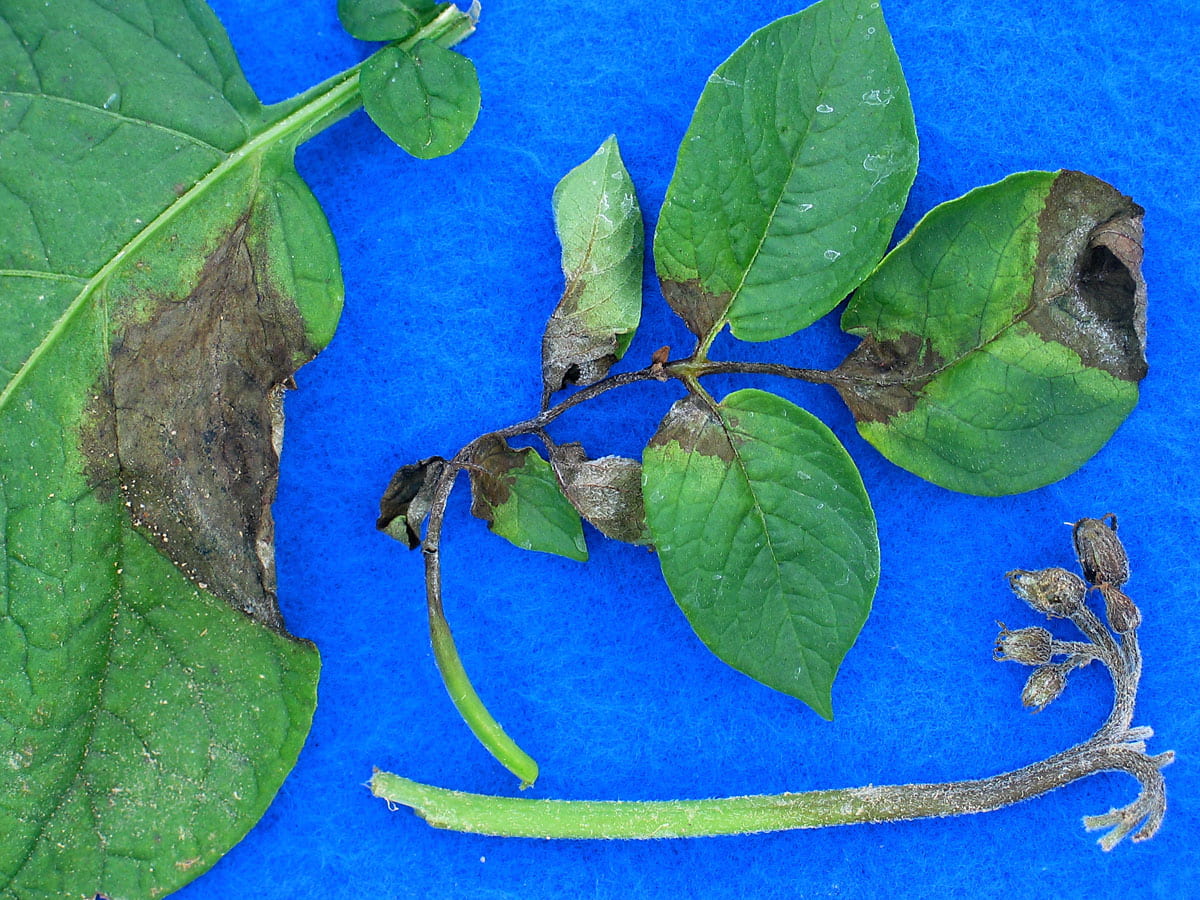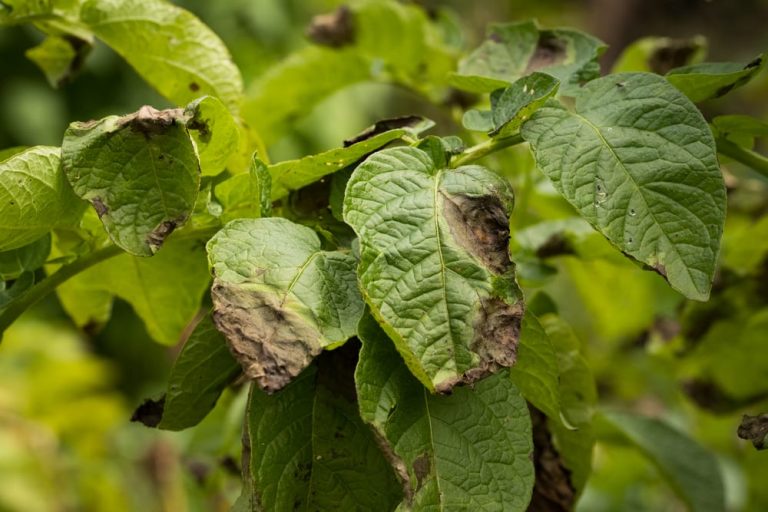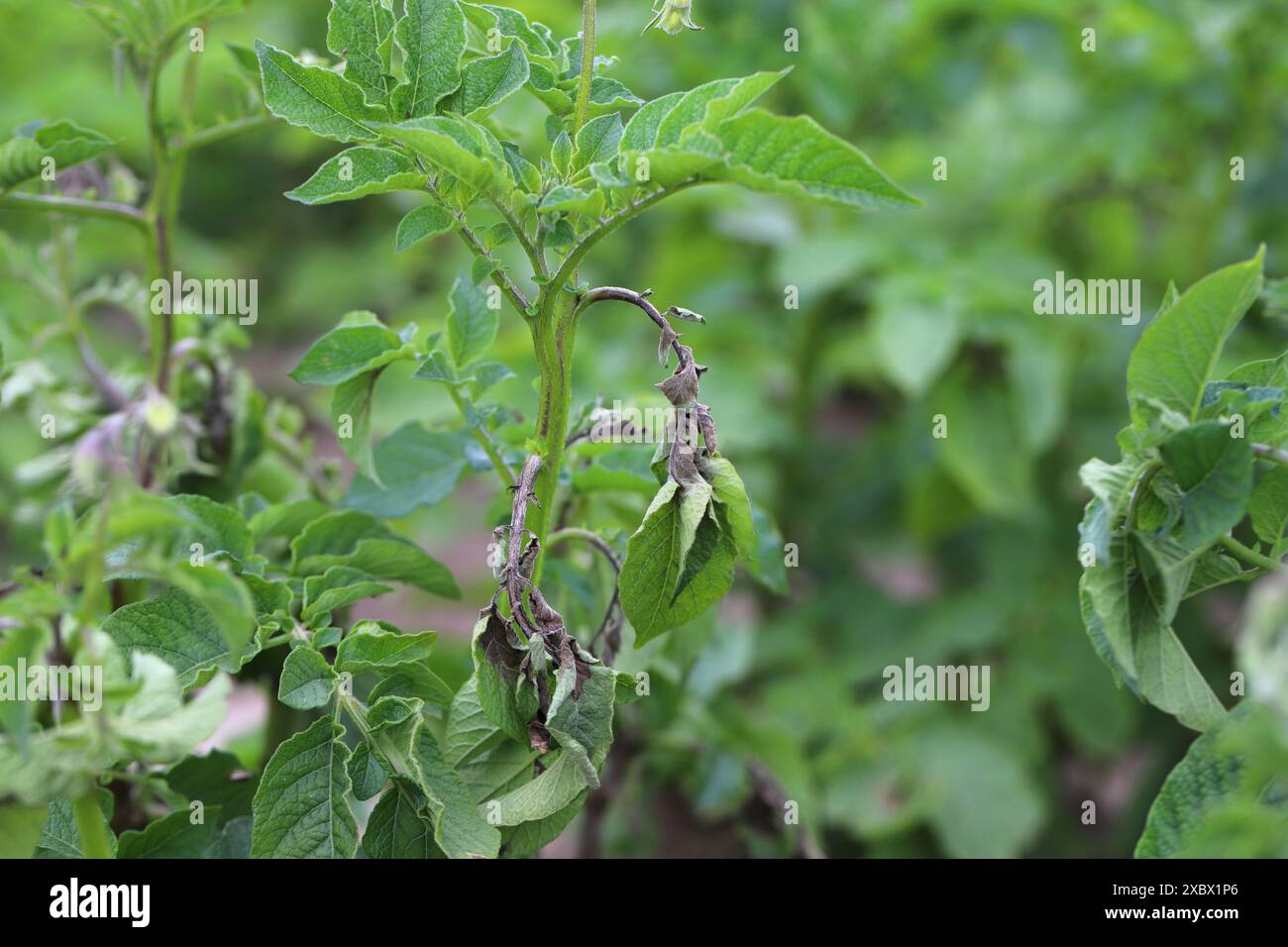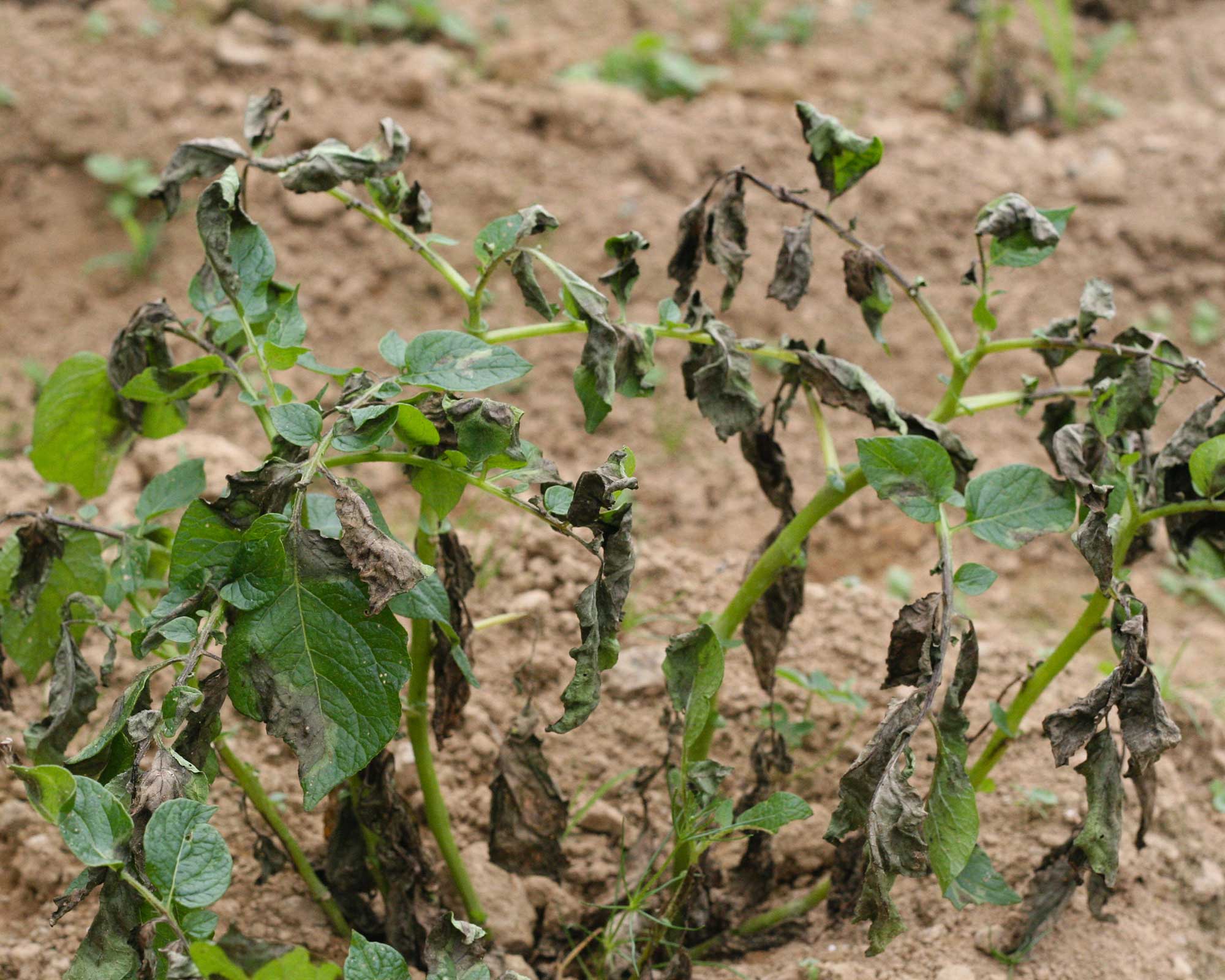What is Potato Blight and How Does it Affect Crops?
Potato blight is a devastating disease that affects potato crops worldwide, causing significant yield losses and economic damage. The disease is caused by fungal pathogens, including Phytophthora infestans and Alternaria solani, which infect the plant and spread disease. Understanding the causes of potato blight is crucial for developing effective management strategies and preventing its spread.
There are two main types of potato blight: early blight and late blight. Early blight, caused by Alternaria solani, typically affects the lower leaves of the plant, causing yellowing and black spots. Late blight, caused by Phytophthora infestans, is more severe and can infect the entire plant, causing white powdery patches and black spots. Both types of blight can significantly reduce potato yields and affect tuber quality.
The impact of potato blight on crops can be severe, with yield losses ranging from 10% to 100%. In addition to yield losses, potato blight can also affect tuber quality, making them unsuitable for consumption or processing. Understanding the causes of potato blight is essential for developing effective management strategies and preventing its spread.
So, what causes blight on potatoes? The answer lies in a combination of factors, including fungal pathogens, environmental conditions, and poor agricultural practices. By understanding these factors, farmers and gardeners can take steps to prevent the spread of potato blight and protect their crops.
In the next section, we will explore the role of fungi in causing potato blight and how these pathogens infect the plant and spread disease.
The Role of Fungi in Causing Potato Blight
Fungal pathogens play a crucial role in causing potato blight, a devastating disease that affects potato crops worldwide. The two main fungal pathogens responsible for potato blight are Phytophthora infestans and Alternaria solani. These fungi infect the plant and spread disease, causing significant yield losses and economic damage.
Phytophthora infestans, the causal agent of late blight, is a highly specialized pathogen that infects the plant through its leaves and stems. The fungus produces spores that are dispersed by wind and water, allowing the disease to spread quickly. Once infected, the plant’s cells are colonized by the fungus, leading to the production of toxins that cause cell death and tissue damage.
Alternaria solani, the causal agent of early blight, is a fungal pathogen that infects the plant through its leaves and stems. The fungus produces spores that are dispersed by wind and water, allowing the disease to spread. Once infected, the plant’s cells are colonized by the fungus, leading to the production of toxins that cause cell death and tissue damage.
Understanding the role of fungi in causing potato blight is essential for developing effective management strategies. By knowing how these pathogens infect the plant and spread disease, farmers and gardeners can take steps to prevent the spread of potato blight and protect their crops.
For example, fungicides can be used to control the spread of potato blight, but their use must be carefully managed to avoid the development of resistance. Additionally, crop rotation and biological control methods can be used to reduce the risk of infection. By combining these approaches, farmers and gardeners can develop a holistic strategy for managing potato blight and protecting their crops.
In the next section, we will explore the environmental factors that contribute to the development of potato blight, including temperature, humidity, and moisture.
Environmental Factors that Contribute to Potato Blight
Environmental factors play a significant role in the development and spread of potato blight. Understanding these factors is crucial for developing effective management strategies and preventing the spread of the disease. Temperature, humidity, and moisture are among the most important environmental factors that contribute to potato blight.
Temperature is a critical factor in the development of potato blight. The optimal temperature for the growth of Phytophthora infestans, the causal agent of late blight, is between 10°C and 20°C. At temperatures above 25°C, the fungus grows more slowly, and at temperatures below 5°C, it is unable to grow. Humidity is also an important factor, as high humidity favors the growth and spread of the fungus.
Moisture is another critical factor in the development of potato blight. The fungus requires a certain level of moisture to grow and spread, and excessive moisture can exacerbate the disease. Weather patterns, such as rain and fog, can also contribute to the spread of the disease by providing the necessary moisture for the fungus to grow.
Soil quality is also an important factor in the development of potato blight. Poor soil quality, such as soil with low organic matter or poor drainage, can increase the risk of infection. Additionally, soil compaction and poor aeration can also contribute to the development of the disease.
Understanding the environmental factors that contribute to potato blight is essential for developing effective management strategies. By knowing how temperature, humidity, and moisture affect the growth and spread of the fungus, farmers and gardeners can take steps to prevent the spread of the disease and protect their crops.
For example, farmers can use weather forecasting to predict when conditions are favorable for the growth and spread of the fungus, and take steps to prevent infection. Additionally, improving soil quality through the use of organic amendments and proper drainage can also help to reduce the risk of infection.
In the next section, we will explore how to identify the early signs of potato blight, including yellowing leaves, black spots, and white powdery patches.
How to Identify the Early Signs of Potato Blight
Early detection of potato blight is crucial for preventing the spread of the disease and minimizing its impact on crops. Knowing how to identify the early signs of potato blight can help farmers and gardeners take prompt action to control the disease and protect their crops.
The early symptoms of potato blight can vary depending on the type of blight and the stage of infection. However, some common early signs of potato blight include yellowing leaves, black spots, and white powdery patches. These symptoms can appear on the leaves, stems, and tubers of the plant, and can be accompanied by a range of other symptoms, including wilting, stunted growth, and reduced yields.
Yellowing leaves are one of the earliest signs of potato blight. As the disease progresses, the leaves may turn yellow or pale green, and may develop black spots or patches. These spots can be circular or irregular in shape, and may be surrounded by a yellow or white halo.
Black spots are another common symptom of potato blight. These spots can appear on the leaves, stems, and tubers of the plant, and can be accompanied by a range of other symptoms, including yellowing leaves and reduced yields.
White powdery patches are a characteristic symptom of late blight, which is caused by the fungus Phytophthora infestans. These patches can appear on the leaves and stems of the plant, and can be accompanied by a range of other symptoms, including yellowing leaves and reduced yields.
Early detection of potato blight is critical for preventing the spread of the disease and minimizing its impact on crops. By knowing how to identify the early signs of potato blight, farmers and gardeners can take prompt action to control the disease and protect their crops.
Regular monitoring of crops is essential for early detection of potato blight. Farmers and gardeners should inspect their crops regularly for signs of disease, and take prompt action if they suspect an infection.
In the next section, we will explore the impact of poor agricultural practices on potato blight, including inadequate crop rotation, poor soil management, and excessive use of nitrogen fertilizers.
The Impact of Poor Agricultural Practices on Potato Blight
Poor agricultural practices can significantly contribute to the development of potato blight. Inadequate crop rotation, poor soil management, and excessive use of nitrogen fertilizers can all increase the risk of infection and exacerbate the disease.
Inadequate crop rotation is a common practice that can lead to the buildup of fungal pathogens in the soil. When the same crop is grown repeatedly in the same field, the fungal pathogens can multiply and become more aggressive, increasing the risk of infection.
Poor soil management is another factor that can contribute to the development of potato blight. Soil with low organic matter, poor drainage, and inadequate aeration can create an environment that is conducive to the growth of fungal pathogens.
Excessive use of nitrogen fertilizers can also contribute to the development of potato blight. While nitrogen is essential for plant growth, excessive use can lead to an overabundance of nitrogen in the soil, which can promote the growth of fungal pathogens.
Other poor agricultural practices that can contribute to the development of potato blight include inadequate irrigation, poor sanitation, and lack of crop monitoring. These practices can create an environment that is conducive to the growth of fungal pathogens and increase the risk of infection.
It is essential to adopt good agricultural practices to prevent the development of potato blight. This includes implementing a crop rotation program, maintaining good soil health, and using integrated pest management (IPM) strategies to control the disease.
By adopting good agricultural practices, farmers and gardeners can reduce the risk of infection and minimize the impact of potato blight on their crops. In the next section, we will explore the concept of resistant varieties and breeding programs aimed at developing blight-resistant potato cultivars.
Resistant Varieties and Breeding Programs
Resistant varieties and breeding programs are essential for developing blight-resistant potato cultivars. These programs aim to identify and breed potato varieties that are resistant to potato blight, reducing the risk of infection and minimizing the impact of the disease.
Resistant varieties are developed through a process of selection and breeding, where potato plants that exhibit natural resistance to blight are identified and crossed with other resistant varieties to produce new, more resistant cultivars. This process can take several years, but the resulting varieties can provide long-term protection against potato blight.
Breeding programs for blight-resistant potatoes are ongoing, with researchers and breeders working to develop new varieties that are resistant to both early and late blight. These programs involve a combination of traditional breeding techniques and modern molecular biology tools, such as marker-assisted selection and genetic engineering.
The benefits of resistant varieties are numerous. They can reduce the risk of infection, minimize the impact of the disease, and decrease the need for fungicides and other chemicals. Additionally, resistant varieties can provide a more sustainable and environmentally friendly approach to managing potato blight.
However, there are also limitations to resistant varieties. They may not provide complete protection against potato blight, and the development of new resistant varieties can be a time-consuming and costly process. Additionally, the use of resistant varieties may lead to the development of new, more aggressive strains of the disease.
Despite these limitations, resistant varieties and breeding programs remain an essential tool in the fight against potato blight. By developing and deploying resistant varieties, farmers and gardeners can reduce the risk of infection and minimize the impact of the disease.
In the next section, we will explore integrated pest management (IPM) strategies for controlling potato blight, including the use of fungicides, crop rotation, and biological control methods.
Integrated Pest Management Strategies for Controlling Potato Blight
Integrated pest management (IPM) strategies are essential for controlling potato blight. IPM involves a holistic approach to managing the disease, combining physical, cultural, biological, and chemical controls to minimize the risk of infection and reduce the impact of the disease.
One of the most effective IPM strategies for controlling potato blight is the use of fungicides. Fungicides can be applied to the soil or foliage to prevent infection and control the spread of the disease. However, fungicides should be used judiciously, as overuse can lead to the development of resistant strains of the disease.
Crop rotation is another important IPM strategy for controlling potato blight. Rotating crops can help to break the disease cycle, reducing the risk of infection and minimizing the impact of the disease. Additionally, crop rotation can help to improve soil health, reducing the risk of disease and improving crop yields.
Biological control methods, such as the use of beneficial insects and microorganisms, can also be effective in controlling potato blight. These methods can help to reduce the risk of infection and minimize the impact of the disease, while also promoting a healthy and balanced ecosystem.
Other IPM strategies for controlling potato blight include the use of resistant varieties, sanitation, and disease monitoring. Resistant varieties can help to reduce the risk of infection, while sanitation and disease monitoring can help to detect and control the disease early, minimizing its impact.
A holistic approach to managing potato blight is essential for effective control of the disease. By combining physical, cultural, biological, and chemical controls, farmers and gardeners can minimize the risk of infection and reduce the impact of the disease.
In the next section, we will provide practical advice for gardeners on how to prevent potato blight, including tips on soil preparation, crop rotation, and disease monitoring.
Best Practices for Preventing Potato Blight in Your Garden
Preventing potato blight in your garden requires a combination of good garden hygiene, proper soil preparation, and careful crop management. By following these best practices, you can reduce the risk of infection and minimize the impact of the disease.
Soil preparation is essential for preventing potato blight. Make sure to rotate your crops regularly, and avoid planting potatoes in the same spot year after year. This will help to break the disease cycle and reduce the risk of infection.
Use resistant varieties of potatoes, which have been bred to be resistant to blight. These varieties can help to reduce the risk of infection and minimize the impact of the disease.
Monitor your crops regularly for signs of disease, and take action quickly if you notice any symptoms. Remove any infected plants, and dispose of them properly to prevent the spread of the disease.
Use fungicides judiciously, as overuse can lead to the development of resistant strains of the disease. Instead, focus on using integrated pest management (IPM) strategies, which combine physical, cultural, biological, and chemical controls to manage the disease.
Maintain good garden hygiene by removing any debris or weeds that can harbor the disease. Keep your garden clean and tidy, and avoid using contaminated soil or water.
By following these best practices, you can reduce the risk of potato blight in your garden and minimize the impact of the disease. Remember to always prioritize good garden hygiene, proper soil preparation, and careful crop management to keep your potatoes healthy and thriving.








